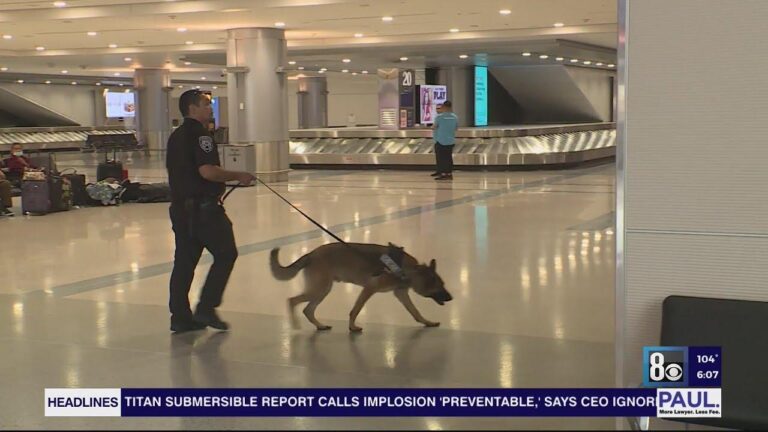Critical Drug Detection Shortfalls at Las Vegas Airport Spotlight Urgent Security Needs
Security Vulnerabilities at McCarran International Airport: The Absence of Drug-Sniffing Canines
In a recent disclosure,the acting U.S. Attorney for Nevada revealed that McCarran International Airport, one of the busiest travel centers in the United States, currently lacks drug-sniffing dogs dedicated to narcotics detection. This deficiency has exposed significant weaknesses in the airport’s drug interdiction capabilities, especially concerning the detection of lethal opioids such as fentanyl. Despite the airport’s high passenger volume and its known challenges with drug trafficking, the absence of specialized K9 units has allowed dangerous substances to evade security checkpoints, raising alarms about public safety and enforcement efficacy.
While standard screening technologies and manual inspections remain in place, they fall short in reliably identifying concealed narcotics. Passengers have reported inconsistent enforcement, with minor items like fruit occasionally triggering alarms, yet more hazardous drugs passing unnoticed. The following points summarize the primary issues undermining drug detection efforts:
- No deployment of narcotics-trained canines: The airport currently operates without K9 teams specialized in drug detection.
- Limited resources: Insufficient personnel and outdated technology hinder comprehensive screening.
- Variable screening protocols: Inconsistent application of detection methods creates security loopholes.
- Heightened public risk: Increased potential for fentanyl and other opioids to bypass security undetected.
| Screening Component | Current Implementation | Recommended Advancement |
|---|---|---|
| Drug Detection Canines | Not utilized | Deploy specialized K9 narcotics teams |
| Screening Technology | X-ray machines and basic chemical sensors | Adopt advanced drug-specific scanning equipment |
| Personnel Training | General security training | Implement enhanced narcotics identification programs |
Insights from the Acting U.S. Attorney: Implications of the Lack of Drug-Sniffing Dogs
The acting U.S. Attorney for Nevada has highlighted the operational challenges posed by the absence of drug-sniffing dogs at McCarran International Airport. This gap substantially hampers the detection of potent narcotics like fentanyl, which have been linked to a surge in overdose deaths across the region. Despite the presence of advanced screening technologies, officials acknowledge that canine units provide an indispensable layer of detection that technology alone cannot replicate.
Key consequences identified due to this shortfall include:
- Increased dependence on manual inspections: TSA agents must conduct more hands-on searches,which slows processing times and raises the risk of human error.
- Missed interdiction opportunities: The inability to reliably detect synthetic opioids contributes to ongoing trafficking and public health crises.
- Difficulty in identifying concealed narcotics: Illicit drugs hidden within everyday items or produce shipments often evade detection without canine assistance.
| Item | Detection Probability | Effectiveness Without Canines |
|---|---|---|
| Fruit Concealment (e.g., mango) | Low | Moderate |
| Fentanyl | High with canine units | Very low |
| Other Narcotics | Moderate | Reduced |
Case Study: Mistaking Fruit for Fentanyl Exposes Training and Technology Deficiencies
In a recent incident at McCarran International Airport, security personnel erroneously identified a ripe mango as fentanyl, underscoring significant limitations in current detection capabilities. The airport’s reliance on human observation and rudimentary chemical tests, without the support of trained drug detection dogs, has led to both false alarms and missed detections. This event has sparked debate over the adequacy of existing interdiction methods at a critical national transportation hub.
Experts point out that the physical resemblance and packaging similarities between harmless items and illicit substances complicate frontline detection efforts. This case highlights the urgent need for investment in:
- Advanced chemical analyzers: Devices capable of rapidly and accurately identifying synthetic opioids.
- Specialized canine units: Dogs trained specifically to detect fentanyl and other emerging synthetic drugs.
- Enhanced training programs: Focused education for security staff on recognizing new opioid variants and lookalike substances.
| Component | Current Status | Recommended Action |
|---|---|---|
| Drug Detection Dogs | Absent at airport | Introduce trained canine teams |
| Screening Technology | Basic chemical testing kits | Invest in state-of-the-art analyzers |
| Staff Training | Limited fentanyl-specific instruction | Expand and update training curricula |
Strategic Recommendations to Strengthen Drug Detection and Canine Deployment
Addressing the critical shortcomings in drug interdiction at Las Vegas airport requires a comprehensive, multi-pronged approach. Prioritizing the deployment of specialized canine units trained to detect synthetic opioids like fentanyl can dramatically improve interception rates. These K9 teams, supported by handlers skilled in behavioral detection, offer a vital security layer that complements technological tools.
Additionally, revising screening protocols to incorporate randomized high-risk inspections and fostering closer cooperation with federal drug enforcement agencies will enhance operational effectiveness.Systematic data collection and analysis should guide resource allocation and optimize canine deployment strategies.
| Focus Area | Performance Metric | Objective | Implementation Strategy |
|---|---|---|---|
| Training Frequency | Monthly training sessions | Maintain peak detection proficiency | Conduct advanced scenario-based drills |
| Canine Deployment | Number of units per terminal | Ensure coverage of all high-traffic areas | Dynamic scheduling aligned with flight patterns |
| Detection Success Rate | Positive detections per 100 screenings | Continuous improvement in interdiction | Regular performance audits and feedback |
| Interagency Collaboration | Quarterly joint operations | Enhance intelligence sharing and coordination | Establish formal partnership agreements |
- Expand narcotics-focused canine teams, emphasizing synthetic opioid detection capabilities.
- Integrate technology-assisted tracking systems alongside traditional detection methods.
- Standardize and increase the frequency of rigorous training to sustain alertness and skill levels.
- Create a clear reporting framework to monitor and evaluate drug interdiction outcomes.
- Strengthen interdepartmental and federal partnerships to facilitate real-time intelligence exchange.
Conclusion: Urgent Need for Enhanced Vigilance Amid the Opioid Crisis
As investigations continue into the missed detection of fentanyl at McCarran International Airport, scrutiny intensifies over current security protocols and resource distribution. The acting U.S. Attorney’s confirmation that no drug-sniffing dogs are presently deployed at this major transportation hub raises pressing concerns about the adequacy of drug interdiction efforts during a nationwide opioid epidemic. Authorities have pledged to implement corrective measures, underscoring the critical importance of bolstering detection capabilities to safeguard public health and prevent the infiltration of deadly narcotics into communities.




